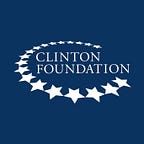How the Clinton Foundation is tackling the U.S. opioid epidemic
Learn how we’re working to reduce stigma, increase access to life-changing resources, and prevent overdose deaths nationwide
By Alex Chan, director of national health, Clinton Health Matters Initiative
According to the Centers for Disease Control and Prevention, more than 33,000 people died of opioid overdoses in 2015 — exceeding the number killed by guns for the first time. In addition, incoming data suggests that more Americans are now dying of overdoses than died at the peak of the HIV/AIDS epidemic, and various studies estimate that 80% of those struggling with opioid use don’t get the help they need.
We know that most overdose deaths don’t happen in hospitals, but in the everyday spaces where people work and live.
Since 2014, the Clinton Foundation has been working to address the prescription drug and opioid epidemic with an emphasis on prevention — how can we reduce the stigma around addiction and encourage people to talk about it openly, and how can we curtail unnecessary deaths due to overdose?
The Clinton Foundation’s Health Matters Initiative (CHMI) is working to build support for substance abuse prevention programs on college campuses, expand access to life-saving medication that can be used in overdose emergencies, and provide people and organizations who have a stake in the ground with the guidance necessary to have an impact.
We believe deaths from opioid abuse are preventable — and that we can use our power of bringing people together to make a difference.
Below are a few examples of what’s working, and why we’re encouraged by progress being made to end the opioid epidemic.
1. Reducing stigma and recognizing addiction as a disease are key to combating the opioid epidemic sweeping the U.S. At this year’s Health Matters Activation Summit, Dr. Judith Feinberg of the West Virginia School of Medicine stressed the importance of being careful to not describe people suffering from addiction as “dirty or clean,” as these can further the stigma.
“Stigma busting” is critical to our work with our partners at the Johns Hopkins Bloomberg School of Public Health. Together, we have convened the academic, clinical, and research community to produce a study that relayed specific recommendations from experts and first-responders alike, and it’s why we’ll continue to drive awareness that brings attention to this important issue.
2. More resources are available to help people who are suffering, and the people who care for them. A number of resources — like this free, comprehensive program we developed in collaboration with Harvard Medical School — are available to empower employers to provide resources and help people affected.
The free online course helps people identify the signs of opioid overdose and teaches them how to administer naloxone (a medication which can halt an overdose in minutes) when necessary, and to connect with others dealing with the disease through discussion forums moderated by Harvard Medical School students.
3. More deaths are being prevented in communities around the U.S. We know that most overdose deaths don’t happen in hospitals, but in the everyday spaces where people work and live. This is why we’re working with Adapt Pharma, the American School Nurses Association, and a number of other partners to make FDA-approved naloxone NARCAN nasal spray available in high schools, colleges and universities, and other community centers where people already are. The spray is simple enough for people with no medical training to administer, and can be critical in saving the life of someone who’s overdosed.
While our hope is that no one needs these medications, we know it’s an important and life-saving tool for the times when they do — just like a defibrillator to a heart patient, or an epi-pen to someone experiencing a severe allergic reaction. To date, we’ve made more than 6,000 doses available around the country, and just announced that we’ll be making nearly 40,000 more available to every college in the country.
We’re working to end the opioid and prescription drug epidemic and are encouraged by progress being made, but we know we can’t solve this problem alone — and that partnerships of purpose are the only way to create real and lasting impact.
If you or someone you know is suffering from addiction or is interested in learning more about what you can do to help in your community, visit the Harm Reduction Coalition’s website to find specific resources in your area.
